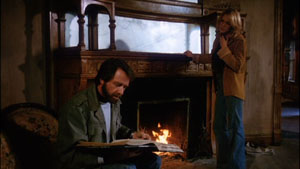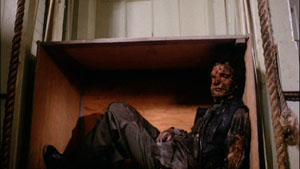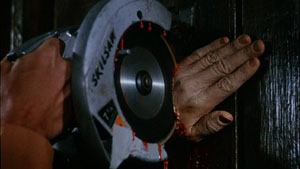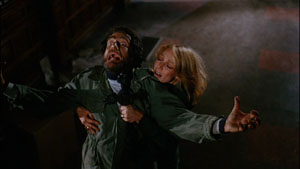Psychologist C.J. Arnold and wife Caroline are in the market for a building to house their drug rehabilitation center. They come across a huge mansion that’s in dire disrepair, but since the price is right, they decide to snag it and fix it up even though Caroline sees a weird apparition while touring the house. She probably should have taken more notice though since this house has a nasty past and surely won’t turn out to be the best environment to house recovering addicts. C.J. gets some of his colleagues and patients together one weekend to help clean up the house and fix it up before opening its doors. Whilst cleaning the basement, he removes a cross stuck between the handles of some cellar doors and unwittingly unleashes an evil force into the house. Caroline’s visions fall on deaf ears, but once the house seals itself up and victims start to pile up, someone better start listening.
 |
 |
I should start off by saying I’m not a huge fan of haunted house films. I can easily count on one hand the ones that I truly love, and while there’s more beyond that that I do enjoy, for the most part these types of films do very little for me. Even though I viewed The Evil with that preconception, I’m still rather certain this isn’t the best the haunted house genre has to offer. A bad story is a bad story, and The Evil has an awful one, something so underdeveloped it’s a wonder they even got the funding to get this thing made (but it was produced by Roger Corman’s studio, so that solves that conundrum). Unless I missed it, I’m pretty sure there’s no mention at all about why all of this is happening, other than it’s a bad house where bad things have happened before and are likely to happen again. Oh, and they do, but it wouldn’t be a proper ghostly abode flick without a true unbeliever, and that’s where Richard Crenna’s character C.J. comes in. He refuses to believe there’s anything supernatural going on and that there must be a logical explanation, even though he’s watching with his own eyes as one of his colleagues nearly cuts his hand off with a power saw, another spontaneously bursts into flames, and people are thrown back by an invisible force whenever they get close to the windows. Hey Colonel Trautmen, IT’S A FUCKING GHOST YOU IDIOT!
 |
 |
Lest I beat this film up too much though, when compared to many other bad haunted house flicks of the 70’s, this one stands out as one that is rarely, if ever, boring, which automatically moves it up a few notches over its similar brethren. After the first 30 minutes, there’s something happening literally every 2-3 minutes, and it keeps things interesting even if you really have no clue why the hell they’re happening in the first place. And really, it’s a good thing The Evil moves along like it does, because regardless of the film’s many shortcomings, it genuinely has to be seen for the final 10 minutes. Without a doubt, the finale is one of the biggest WTF moments I’ve seen in a very long time, and if you thought the ending of Fulci’s The Beyond was a head-scratcher, you haven’t seen anything until you’ve seen this. Throw in some hilariously bad acting (the hapless electrocution victim is a real highlight) and a horny ghost that isn’t above ripping chick’s clothes off (see, he’s not ALL bad), and The Evil is likely to keep you entertained just enough to warrant a viewing when you invite some friends over for your next bad movie night. Shout! Factory has paired The Evil with Twice Dead in another Corman double feature, this time presented in grindhouse fashion, much like Dark Sky’s Drive-In Double Features from a couple years back. You can choose to watch the film’s solo, or choose “The Roger Corman Experience” and watch them back-to-back with trailers before and in-between. The Evil gets a pretty solid 1.78:1 anamorphic transfer, and while a couple of scenes look a bit washed-out, overall there’s very little to complain about. The mono audio track is free of any hiss and well-balanced. Continuing Shout!’s great run of getting people together for commentaries on films no one else would give any effort to, director Gus Trikonis, writer Donald G. Thompson and director of photography Mario Di Leo talk about filming in the old Vegas hotel used for the setting and overcoming budget hurdles to get the film to turn out how they wanted. Also included is a trailer and TV spot for the flick.
Please feel free to discuss "The Evil" here, in our forums!